I used to be in shape. Really. Two hundred push-up, 20 chin-up kind of shape. I would blaze through 50km ski trails. That, of course, was then.
This post originally appeared on MoneySense.
As the decades piled up, exercise became less important, less frequent. Injuries began to take their toll, further limiting my activity, and at some point I came to the realisation that nachos, not eggs, were nature’s perfect food. The predictable result is that today I am but a shadow — a soft, blurry-edged shadow — of the 65kg athlete of yore.
While I’ve made my peace with the long dénouement of middle age, occasionally, when I glance at old photographs or step carefully around the bathroom scale, I can’t help wondering: What if I decided to set up a home gym and turn back the clock just a bit? What would it take? How much would it cost? And where would I even start?
Indeed, the neglected home gym, replete with Bowflex coat racks and fossilized elliptical trainers, is a universal cliché. “The best time to buy fitness equipment is a month-and-a-half after Christmas,” points out Wayne Boucher, fitness and wellness coordinator at Fitness Zone, the massive school gym at Algonquin College’s main Ottawa campus. “Exercise gear is given as Christmas presents or purchased as part of a New Year’s resolution to get fit, and by mid-February it turns up for sale on websites.” If you build it, will you come?
Yes, you can construct a home gym for less money than you might think. But should you? “Home gyms aren’t for everyone,” acknowledges Shantelle Meaney, kinesiologist and fitness supervisor at Calgary’s Preventous Collaborative Health. “Some people need to get out of the house or they simply can’t motivate themselves to exercise regularly. The biggest mistake people make is they have big dreams of getting fit, and they go out and spend a ton of money on equipment like a treadmill that they never end up using.”
In order to avoid making these kind of expensive, guilt-laden mistakes, Meaney suggests starting any home gym project small, and building upon it only if you actually make use of it.
A Room with a View (of Yourself)
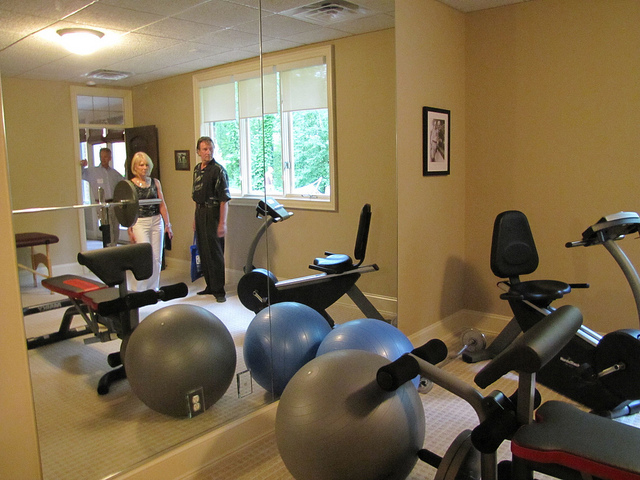
It’s hard to get a workout in when you’re beset by screaming kids or overflowing laundry hampers. “When you’re setting up a gym, it’s important that you make the space your own, a refuge from all the hectic distractions of the home,” says Meaney. “Ideally, you want a dedicated room with a door that you can close so your workout isn’t interrupted, perhaps with a stereo to help block out external noise.” Oh, and at least one full-length mirror — a mere $US20 — to see yourself from head to toe is important. “If you can watch your form and technique as you exercise it will dramatically lower your chances of injury,” says Meaney.
Adds Boucher: “Sometimes it can be as simple as pushing the coffee table to the side of the living room, laying down a six-foot-square yoga mat, which you can buy for $US100, and you’re good to go.”
Ottawa Senators conditioning coach Chris Schwarz agrees that modern home gyms don’t have to be big. “We’re moving away from machines where you can do eight exercises and it takes up a whole bunch of space,” says Schwarz, who, in addition to training elite hockey players, runs the Fitquest chain of Ottawa-based studios specializing in exercise rehabilitation. As for mirrors, he says they can be useful, but advises caution. “Mirrors can be counterproductive because they lead people to work on the muscles they can see, like biceps and pecs, but not the one’s they can’t see, like triceps or back muscles, which can lead to imbalances and problems with posture.”
What Are You Training For?
OK, you’ve got your space, with or without mirrors, stereo, and floor mat. What about the actual exercise equipment? What you buy should depends on your objectives — weight loss, cardio fitness, strength training, or some combination thereof — but it’s not quite as simple as that. “People looking to lose weight think it’s all about cardio, getting the heartbeat up and burning calories,” says Boucher. “What they don’t realise, though, is that cardio exercises alone aren’t enough. After three weeks or so your body adjusts and you stop losing weight.”
Instead, a combination of cardio and resistance training is best for weight loss and overall fitness — even though that message itself is sometimes resisted. “My female clients often don’t want to do resistance training because they think it’ll add muscle bulk and increase body weight, but that’s not true. It’ll simply tone muscles and add definition.”
Dumb and Dumber
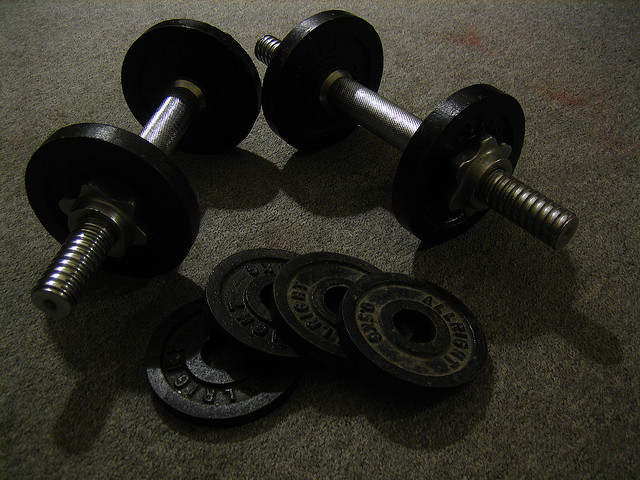
“A set of dumbbells should be part of every home gym,” says Meaney. “Either the three weights you think you’ll use most often, like 2kg, 5kg and 7kg for women, or, better yet, one of those good quality adjustable sets.”
Adds Boucher: “Adjustable dumbbells that add plates with the click of a switch, from 1kg to 20kg, are a great foundation for a home gym. They’re compact and provide a virtually unlimited palette of exercise options.”
A Stable Stability Ball
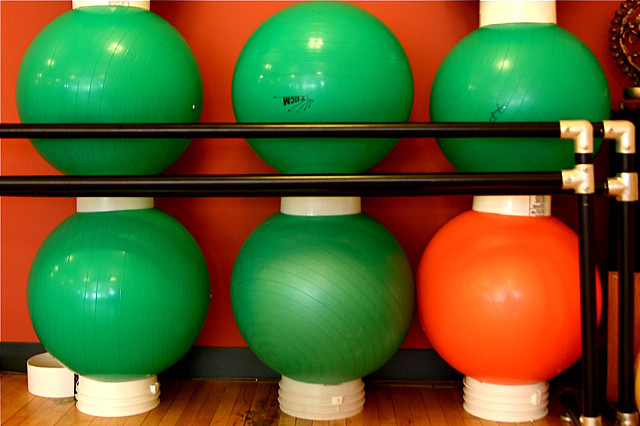
If Charles Atlas saw you exercising with a stability ball — nothing more than a reinforced beach ball, really — he’d undoubtedly kick sand in your face. And possibly pull a hamstring, groin, or abdominal muscle in the process. That’s because old-time iron pumpers were all about muscle isolation exercises for maximum bulk and, unfortunately, minimal flexibility. Modern trainers know better, which is why, next to dumbbells, a good quality stability ball tops the list of prescribed home gym accessories.
“A lot of people have poor balance and low core strength,” points out Meaney. “With a stability ball you can do abdominal crunches, squats, hamstring curls, body bridges — a ton of different exercises. They’re inexpensive, easy to store, and they can double as a bench when working with dumbbells.” A word of caution: “Don’t buy the see-through ones you can find at big-box stores. They could end up popping on you, leading to serious injuries. The good quality ones they sell at fitness outlets have been tested to several times your body weight.”
Strike Up the Bands
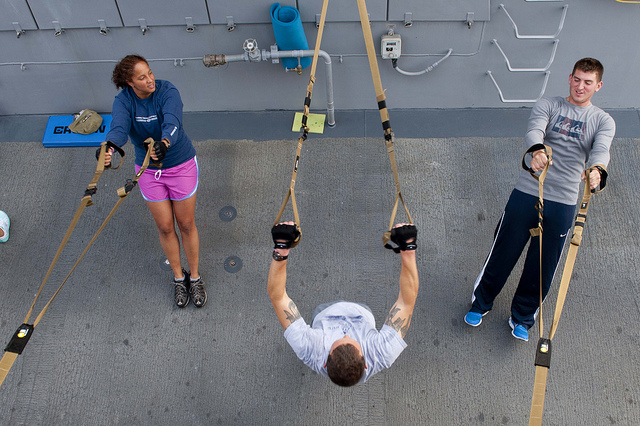
Resistance bands are deceptively low-tech and extremely versatile. In their simplest form, they’re nothing more than a roll of elasticized plastic banding or tubing you can cut to length and use in place of dumbbells for any number of exercises where light to moderate resistance is required. More advanced systems come with handles and door attachments. “Strap it to a door, table or bench, and it’s a cheaper version of a universal machine,” says Meaney. “You can do lat pull-downs, standing chest presses, squats, shoulder-related exercises.”
For tougher, more advanced workouts, a number of so-called suspension training systems have been developed. “Systems like TRX or the Human Trainer involve straps you can attach to ceiling trusses or doors, and your body weight becomes the resistance,” says Schwarz. “They’re light, compact, don’t cost more than a couple hundred dollars, and you can do 50 to 100 exercises with them.”
Don’t Skip the Cardio
Move about a bit and get the ol’ ticker working. “Skipping is a brilliant exercise,” says Boucher. “Not only is it a fantastic cardio workout, but that up-and-down motion tightens the muscles around the organs, strengthening your core.” And if your ceilings are too low to accommodate skipping? No problem: There are now “ropeless” skipping ropes on the market — weighted handles, basically — that mimic the benefits of skipping without scraping or scuffing interiors.
Says Meaney: “Try developing a cardio circuit, where you move from skipping, to jumping jacks, to aerobic steppers — anything that keeps the heart rate up. It doesn’t have to be expensive or high tech.”
“Indeed,” agrees Schwarz, “setting up two pylons and doing lateral shuffles between them will give a much better workout than, say, riding a stationary bike, which is just a single repetitive movement.”
Big Ticket Items
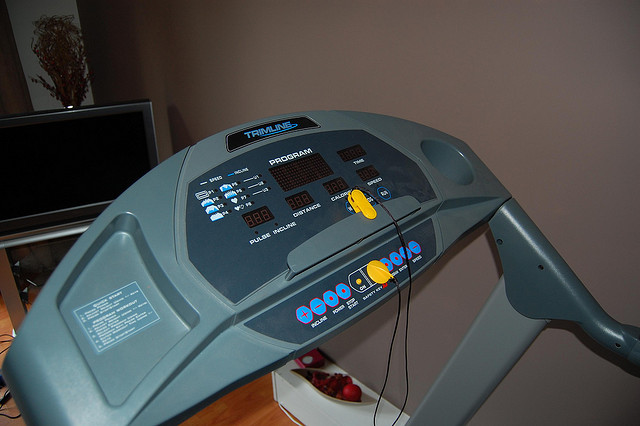
Fine, but what if you really want one of those impressive contraptions: the elliptical trainers, spin cycles, or Bowflex-type machines? If you love running, but not during the winter, by all means get yourself a home treadmill. Know what you’re getting into first, though. “Some treadmills are like running on a slab of concrete, some like running through a fluffy field,” says Schwarz. If you want the fluffy field type, be prepared to pay: “A top-of-the-line Woodway treadmill costs between $8000 and $10,000, whereas a more modest Precor treadmill, also good, will run you $2000.”
Elliptical trainers, meanwhile, present their own problems. “A lot of them have patented movements, so they can’t be adjusted,” says Schwarz. “A movement that might be right for a five-foot woman might not be right for a six-foot-five man.”
As for traditional cable-and-weight-stack machines, he calls them “very dysfunctional” because the locked-in motion can lead to repetitive strain. Instead, he recommends buying a stand-up functional training system with adjustable arms “so the cables aren’t always coming from the same angles.”
Fit, Not Bankrupt
Again, all this stuff can cost a fortune. In addition to using websites like Kijiji to find barely used exercise equipment at steep discounts, you can also contact equipment manufacturers or retailers. “Gyms are always going out of business, or they lease from the manufacturers, so there’s a lot of gym-grade refurbished equipment out there that’s selling for about the same price as you can get home-quality machines new,” says Boucher. “Go to Fitness Depot or Life Fitness or manufacturers like Precor and ask.”
But maybe dumbbells, balls, and bands are good enough. After all, says Boucher, “the poor man’s gym works as well as the rich man’s gym if you’re putting the same work in.”
Get buff, not broke [MoneySense]
Mark Anderson is a contributor at MoneySense. MoneySense produces Canada’s leading personal finance magazine and website. Over the past decade, MoneySense has become the country’s most trusted source of information on investing, banking, RRSPs, insurance, financial planning, saving for education, home buying, real estate investing, car buying and much more.
Images via Tina Mailhot-Roberge, Official US Navy Imagery, Clarkston SCAMP, i am a moose (Flickr).
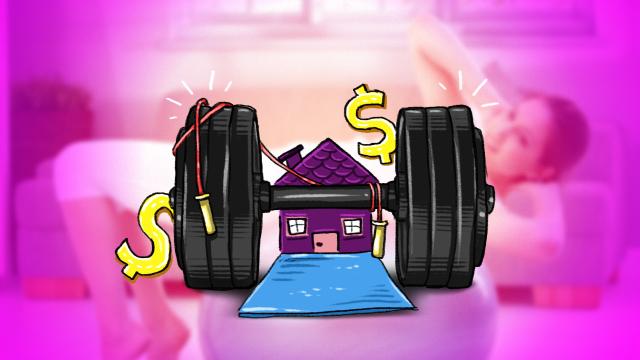
Comments
11 responses to “Get Buff, Not Broke: How To Build A Budget-Friendly Home Gym”
Get a bar/rafter, a branch in your backyard or something that you can comfortably (and safely) hang from. Do chinups/pullups muscleups, front levers/back levers, dips. regular and handstand pushups. When they all get hard (or boring), try doing them explosively (adding a clap or two, while you’re doing each rep) or with one arm or with adding weight. That’s your upper body workout done. Costs maybe $15-20 bucks if you go the hardware store route, a bit more if you’re looking for the door mounted ones though I think.
Agree. It’s pretty simple. Half hour a couple of times a week of a chin-up/push-up/sit-up until fail rotation is all I need.
Umm no. Get a decent squat rack, a barbell, a set of weight plates and a bench. That’s it.
This. 100%.
Kettlebells.
Use google for workouts. here’s a great one: http://www.youtube.com/watch?v=tfrRVi080Js&NR=1
no need for rack,barbell, plates, bench – just use dynamic movement and get huge with functional strength and not end up looking like a roid muncher.
Your suggestion covers only strength training, takes up a fair amount of space and costs more than everything except the ‘big ticket items’ mentioned above.
It’s good advice, but your comment isn’t exactly a drop-in replacement for the article.
If you want to do cardio, lift the weights FASTER!
I made some serious suggestions in my other post for indoors cardio but to be perfectly frank if squats don’t make your heart beat fast then you aren’t doing them right!
Those click to adjust dumbbells are ridiculously expensive. They’re only a good idea if you are weak and have lots of money.
“If Charles Atlas saw you exercising with a stability ball — nothing more than a reinforced beach ball, really — he’d undoubtedly kick sand in your face. And possibly pull a hamstring, groin, or abdominal muscle in the process. That’s because old-time iron pumpers were all about muscle isolation exercises for maximum bulk and, unfortunately, minimal flexibility. Modern trainers know better, which is why, next to dumbbells, a good quality stability ball tops the list of prescribed home gym accessories.”
…yeah Charles Atlas was as tight as a drum http://www.artofmanliness.com/2008/01/08/every-man-every-day-should-do-these-exercises/
The author is right in general though. Muscle makes you muscle bound. Here’s modern Mr Olympia Ronnie Coleman. A ridiculously muscled man doing the splits. http://forum.bodybuildingpro.com/filedata/fetch?id=100111
Physical culturists (the turn of the last century name for what we’d call bodybuilders/weightlifters) didn’t do isolation exercises that much and focused on compound movements. They were well rounded and had excellent flexibility and mobility. That doesn’t make modern fitness trainers sound special though. Better to pretend the stability ball and flexibility is some new idea.
Even if they did do isolation exercises, they don’t inherently make you less flexible. Flexibility (or mobility as actual quality strength trainers/exercise physiologists prefer to put the focus on) is brought about through a combination of factors and interventions that take a persons current mobility issues into consideration. It’s not achieved by making every exercise try and fulfill multiple goals aka squats on a stability ball. Strength work for strength. Mobility work for mobility. You can’t add multiple goals in the one exercise modality without ending up compromising both goals.
Swiss balls are fine and have numerous uses but they aren’t an essential. You can train your core, mobility, flexibility etc, using good old fashioned compound movements, stretches, and mobility drills.
The TRX however is a great suggestion. My essential list for a home gym would be:
1, squat rack with bench
2, barbell and dumbbell with weights (not the click adjustable types they are ridiculously expensive)
3, TRX
With that you can do just about everything you need to do.
Can’t run outside? Do a circuit. Do burpees. Plenty you can do inside with minimal space. People underestimate how hard you can make repeatedly lying on the ground and getting back up.
Edit: oops, wrong button
Adds Boucher: “Sometimes it can be as simple as pushing the coffee table to the side of the living room, laying down a six-foot-square yoga mat, which you can buy for $US100, and you’re good to go.”
I’m so glad I came to lifehacker today. There was this table in my room and I was all like: “dude, what do I do with this?”
A good post @markxx
I always appreciate people who are interested in knowing about home gym as it is being needed by many busy office goers.
I also have a home gym developed.
Expecting more posts related to home gym! 🙂
Thanks for the post.